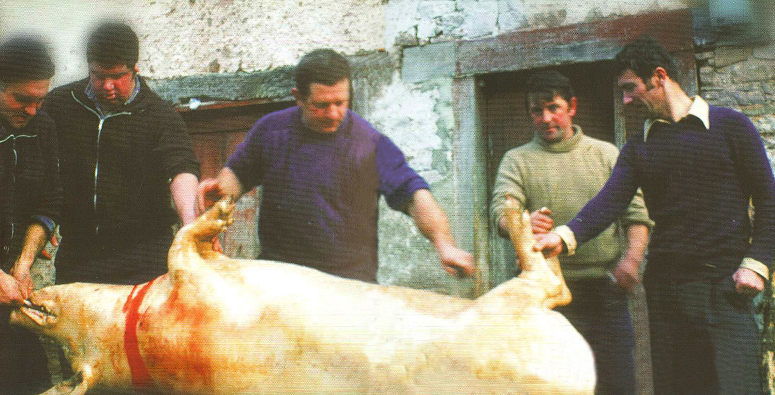In our farmhouses it was customary in the whole of our territory to breed domestic animals, fatten them up and slaughter them to be eaten. Amongst the livestock raised for meat there were pigs, lambs and sheep, goats, rabbits and fowls (hens, cockerels…). The fresh meat of cows, calves and other cattle was reserved for wedding receptions or other extraordinary family celebrations.
The slaughtering of domestic animals took place at different times of the year so that meat and lard supplies would last throughout the year. Otherwise, and as the saying goes: “Zerririk ez bada tegian, koiperik ez zartagian” (If there is no pig in the sty, there will be no lard in the pan). Lambs and young goats were butchered in spring; sheep and pigs in autumn or beginning of winter; and birds and rabbits according to need.
Nevertheless, pig slaughter has surely been the most popular of them all, and until not so long ago! Still in the 1960s at least a pig was killed in every farmhouse. To rear and slaughter a second pig was a sign of wealth, and in those cases, the first pig was taken from the sty and put to death in November and the second in February generally.
“Txerriaren bizitza ona baina laburra da” (The life of a pig is good but short). Pigs are fed edibles from the cultivated fields: potato, cabbage, turnip, beetroot, pumpkin, acorn…, and whey in sheep farms. In the region of Bizkaia the mixture of vegetables and tuberous crops prepared to feed the pig receives the name ozala.
Although nowadays pig slaughter was normally conducted in November, around Saint Martin’s Day, in the olden days, and particularly in some localities, the custom used to be observed in December with a view to cater the Christmas dinner table with abundance of ribs, loins, black pudding… Besides, the belief that the pig should be slaughtered with a descending moon was widespread and still prevails.
Neighbours and relatives were called for the special event. There were enough jobs for all wanting to help, men and women alike. No matter how much work was waiting to be done though there was always a little time for entertainment after lunch; say playing cards or just chatting.
The pig was slaughtered early in the morning. The help of four or five men was required: the animal was taken from the sty, laid on a table and held by all. While the slaughter man did his job, a woman collected the blood for making black pudding or blood sausages to a vessel, stirring continuously the blood with her hand so that it did not curdle.
The bulk of the work came next. Let us give a brief insight into the next procedures. The dead pig is covered with fern and burned, the charred remains are washed away with water, the animal is cut open from the head down to the rear side and the innards removed. Next it is hung from a tall spot and kept there for several hours until the meat cools down. The above-mentioned steps are similarly followed nowadays. However, meat preservation has notably evolved since past times. This is in short how our ancestors did it.
The following day the pig was butchered and lean meat was cut and ground to produce various sausages. When hams, shoulders and bacon sides shed most of the water, they were stored for five to six days in chests filled with salt; then they were soaked and finally hung for them to dry cure slowly. Bones, hams, ears and snout were kept in salt all year round.
Loins and rib racks were sometimes introduced in brine or salt for twenty-four hours after having been hanging for some days, and chops and ribs were afterwards preserved in lard.
Pig slaughter provided meat and edibles for months to come. Chests were full of salt-cured meat and farmers were prepared to face winter.




